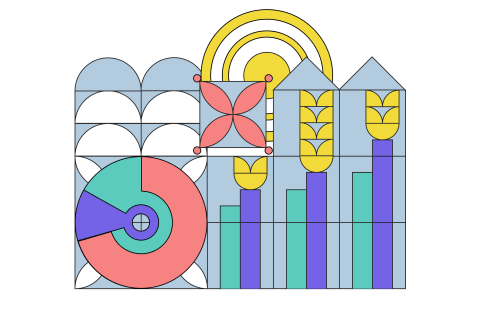How to calculate the ROI of your digital product?
Digital products are often made to fulfill a business need, whether it’s making a profit or improving brand awareness. Regardless of what that purpose is, there is one metric that you can hear people using: the return on investment, which describes whether the investment was worthwhile. Depending on their nature, returns on investment can be soft, hard, or social. What are they, and how do you calculate ROI? Read on to find out.

Table of contents
What does ROI stand for?
ROI is an acronym for Return on Investment, a basic metric that tells whether an investment was worthwhile.
How to calculate ROI? ROI is calculated as the ratio between profits and the cost of investment:
ROI = (Present Value – Cost of Investment / Cost of Investment)
For example: if you bought shares for $1000 and sold them for $3000, then your profit is $2000. In that case, how would you calculate ROI? Simply, it’s: ($3000 - $1000)/$1000. Your return on investment would equal 2, which tells you that you made twice as much as you put in (source). Not every digital product brings financial returns, but even then it can bring a positive return on investment.
How to calculate ROI of non-financial returns?
Non-financial returns on an investment are well known in the world of marketing, where ads don’t need to generate sales to be considered successful. Marketing campaigns often aim to reach long-term, intangible goals: increased brand awareness, employee retention, and customer equity. Some specialists even go as far as to say that, “If an ad doesn’t increase brand awareness, it’s not doing its job” (source). Digital products, in their versatility, can bring different returns as well:
- an engaging landing page increases the conversion rate for an e-commerce store,
- a mobile app with great UI/UX design improves customer satisfaction,
- automatization of a financial process saves the time needed to complete each task.
Calculating the ROI for each of these digital products can come down to estimating how much money they save.
Let’s say that an app built for the HR department saves 50 working hours every month and costs $10,000 to develop. Before we start thinking about how to calculate ROI of this product, we need to know the average wage of an HR specialist in that organization. For the sake of argument, let’s assume that 1 working hour is $50. In that case, the total ROI after one year would be:
(12 x 50 x $50) - $10,000 / $10,000 = $20,000 / $10,000 = 2
We have calculated that the ROI for this digital product is 2, so the time savings justify the investment in the app. But even if the ROI for that example was less than 1, it would only imply that it wasn’t a good investment in the short term. Savings would accumulate over time and if the app was still being used for the next year or two, the ROI for that period would justify the one-time investment of $10,000.
Do we always need to calculate ROI of a digital product?
Many believe that since calculating ROI was created for the sake of financial investment, it should only be used in that context. The history of IT holds many examples where ROI wasn’t even considered, but the projects turned out to be successful investments: the first Linux server for corporate websites, the first Wang word processor, or the first spreadsheet program for Apple II (source).
Projects like these are the reason why some people went from thinking about how to calculate ROI for their digital product, to wondering if they should even do it. These Investments had a huge impact on the industry - or even the world itself - and their success could have never been predicted with a single equation. And that is one of the most popular criticisms of using ROI metrics - that it oversimplifies the decision-making process.
Hard, soft, and social: different flavors of ROI
Here, at Boldare, we measure both soft and hard ROI. The distinction between the two was best described by one of our Java developers, Mateusz Grzesiukiewicz while talking about the benefits of scaling monolithic apps:
That might be ‘hard ROI’ such as financial return, number of users, ratings compared to other apps, SLA performance, etc. or ‘soft ROI’ such as improved user experience, efficiency, teamwork, morale, or employee retention.
Hard ROI is a simple concept: it’s anything that can be measured and calculated, but you have little influence over it. The number of visits to your website can change over time, your sales might go up, but your actions will only be a fraction of a reason why it happened.
Soft ROI is another story: it can be measured, calculated, and you have some influence on the outcome. For example: if a business owner decides to introduce free lunches for its employees, morale will go up and people would work more efficiently. In that scenario, soft ROI would be an increase in employee efficiency, achieved with the cost of buying hot meals for everyone. An intangible benefit that was acquired through financial means.
Soft ROI can be calculated as customer satisfaction — here’s how to do it
To calculate soft ROI, there needs to be a way to measure the outcome. There are universal metrics that can be used to measure soft ROI, one of them being Net Promoter Score (NPS for short), used to describe customer loyalty and satisfaction.
Net promoter score is one of the metrics that can tell you if your customers are happy with your service/product. The idea is simple: satisfied customers are more likely to recommend you to others. To find out if that’s the case, ask your clients this question: On a scale from 1 to 10, would you recommend our company to your friends or colleagues? The exact wording of that question can be altered, but the principle remains the same: you want your clients to give you a score from 1 to 10 (source). Depending on their answer, you can assign them to one of three categories:
- if they gave you a score of either 9 or 10, they are promoters,
- if they gave you a score of 6 or below they are detractors,
- if they gave you a score of 7 or 8, they are passives.
To calculate your NPS, you need to count your promoters and detractors and see how big of a percentage they are of the whole group. Then you need to subtract one from the other:
Net Promoter Score = Promoters (%) – Detractors (%)
For example, if you collected 50 surveys, of which 20 were scored 6 or below, and 25 were 9 or 10, your NPS would be:
(25/50) x 100% - (20/50) x 100% = 50% - 40% = 10%
NPS is just an example of how to calculate soft ROI. A real-life application differs from the one presented above as not every soft ROI can be so easily measured. At Boldare, NPS is just one of the metrics that we use to keep track of our clients’ satisfaction levels.
Social ROI and measuring the community
Mateusz also sees a clear distinction between hard ROI, soft ROI, and the matter of social impact, measured by social return on investment, aka SROI:
Then there is ‘social ROI’ which is less tangible and measurable, such as the impact on culture, or tackling an issue of wider social importance. Such impacts may seem one step removed from the project’s focus (modernizing your monolithic app!) but often tie in neatly to the ‘corporate social responsibility’ goals of many modern companies.
Social ROI is about building and taking care of the community which in a business setting can be expressed as an organization’s mission, ethics, or culture. It is also team morale or relationships between colleagues: that is why employers organize social events, such as team parties or work trips. The link between financial investment and social ROI is best described by a simple equation:
SROI=SIV−IIA / IIA×100%
where:
SIV=social impact value
IIA=initial investment amount
(source)
However, just as with soft ROI, there is no simple way to measure the impact of social events. Social ROI is not a metric in a traditional sense, but one that is worth keeping in mind when planning your strategy. At Boldare, we increase social ROI in our own way:
- We support social impact organizations that promote values that we believe in. Some of these initiatives have sparked the creation of internal communities within our organization.
- We want every team to meet face to face at least twice a year. This is to ensure that even with a hybrid work model, people get to know each other.
- We built a separate role called Ethical Guide, that watches over how our business impacts the environment.
How to calculate ROI of your digital product
When developing a digital product in Scrum, one of the Agile frameworks, answering the question of how to calculate ROI takes more than the simple math of dividing costs and profits. What matters is how well the client budget is being used, and how many sprints it will take to build the digital product.
For example, the performance of an Agile team can be measured as “payback analysis, return on investment, net present value, etc.” (source) At Boldare, when developing a digital product, we calculate our ROI based on four main factors:
- client satisfaction,
- team morale,
- sprint goal achievement (the percentage of completed sprint goals),
- sprint predictability (teams’ consistency in achieving their sprint goals).
These are the metrics that we use when working with a client and in practice, the ROI depends on:
- quality of content,
- features and services offered by the digital product,
- marketing strategy,
- current situation in the industry.
And just as with anything else, the ROI for a digital product can be soft, hard, or social. But before you start calculating any of them it’s worth looking into every benefit that your product can bring and whether they can be measured. After all, the right metric can be your key to success.
Share this article:








